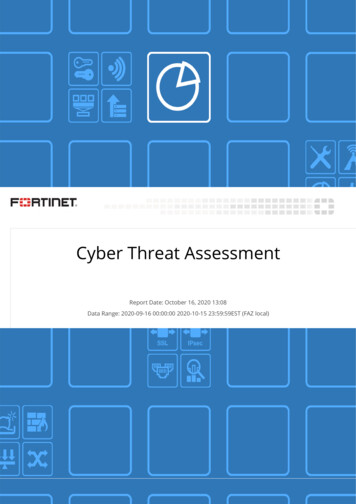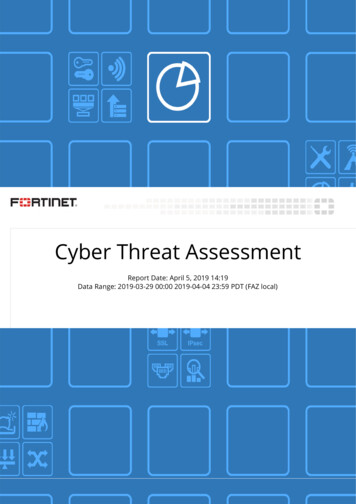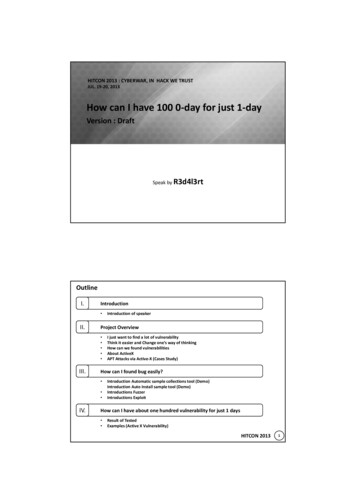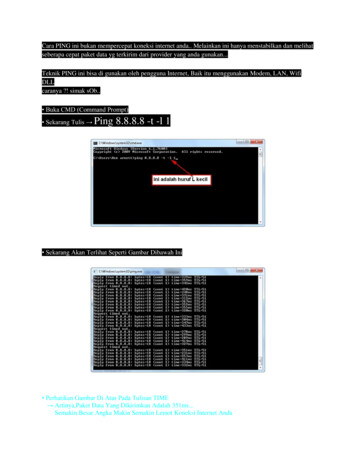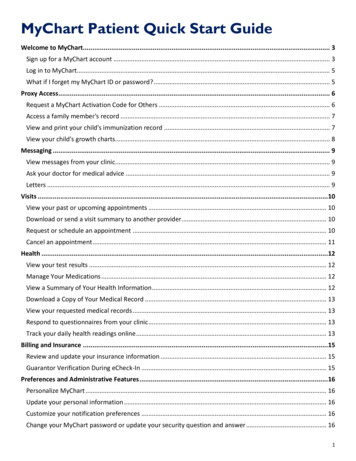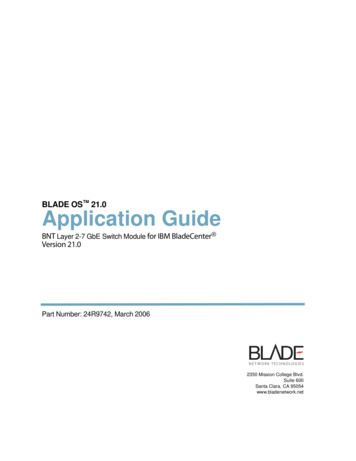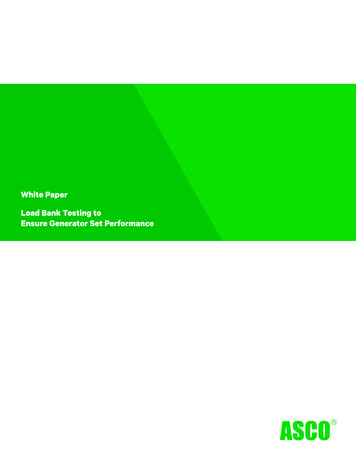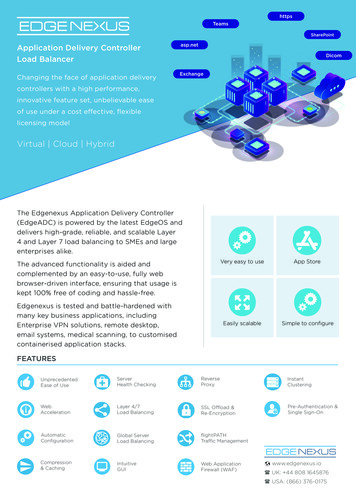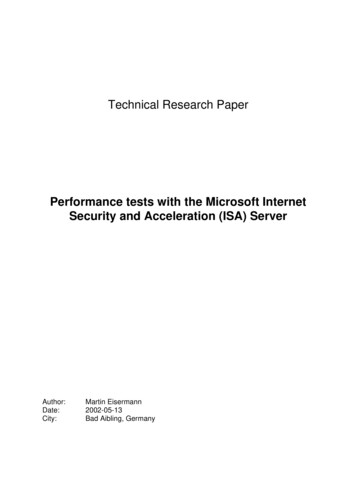
Transcription
Technical Research PaperPerformance tests with the Microsoft InternetSecurity and Acceleration (ISA) ServerAuthor:Date:City:Martin Eisermann2002-05-13Bad Aibling, Germany
Annotations:This research paper is an extract from an about 100 pages enfolding diploma thesisof Martin Eisermann, student at the Fachhochschule Rosenheim (University ofApplied Sciences), Germany. It contains the results of performance tests,accomplished with MS Proxy Server 2.0, MS ISA Server and Linux Squid Proxy.This work reflects the personal impressions and test results of the author, made withweb performance testing software, described later in this document.The paper is a translation from German into the English language, so it might not bewritten with the best phraseology.Microsoft, Windows, Windows NT, Windows XP, Internet Information Server (IIS),Web Application Stress Tool, Internet Security and Acceleration (ISA) Server, Proxy2.0 are either registered trademarks or trademarks of Microsoft Corporation in theUnited States and other countries/regions.Other products and Company names mentioned herein may be trademarks of therespective owners.
Index1.Executive Summary.42.Test scenario.53.Test tool selection.64.Test specification.85.Choosing the proxy products.86.The test results.96.1Web server (standalone).96.2MS Proxy 2.0 vs. MS ISA-Server.116.3 Linux Squid vs. MS ISA server.137.Summary.16
1. Executive SummaryThis technical research paper contains the results of a performance test scenariowith the Microsoft Internet Security and Acceleration (ISA) server, which should makeclear, how good proxy servers can improve the speed of a web server.At the beginning, it describes the structure of the test scenario, with aspects ofhardware and software. Then, a product will be chosen from a variety of different testtools, which compete with each other. The benefits and drawbacks of every productwill be elucidated. The next chapter explains, which products will be compared withthe MS ISA server and why they were selected. The following test results arerepresenting the biggest section in this research paper. Finally, there is a shortsummary of the newly gained cognitions.
2. Test scenarioTo get an impression, how proxy servers can improve the performance of a networkor of a single web server, the following scenario was build:100 MbitWebserver(IIS 5.0)100 MbitWorkstationsProxy Serverill. 1The workstations shown in illustration 1 are simulating the internal LAN (local areanetwork) clients, which are among themselves connected with a fast Ethernet switch(100 Mbit). The web server, which is also connected with 100 Mbit, simulates theInternet. However, this network capacity is mostly not found in small and/ or middleenterprises, but for compensation, the web server is an outdated machine. Thetechnical data of all components used for the tests is described in table 1.Technical data:Systemweb serverproxy serverWorkstationsCPUMHz RAMOSPentiumAMD DuronPentium II200800400Win XP Prof., IIS 5.0variableWin NT 4.0 Prof.96 MB512 MB256 MBTab. 1
3. Test tool selectionIn the Internet, it is not difficult to find programs, which can execute diverseperformance tests for web servers. Many of them, especially if they are build forLinux, are free of charge, but if one likes to have graphical analysis it gets moredifficult.Often one has to decide using a Microsoft Windows 32-bit application,which, in general, costs a lot of money.Another problem is the possibility to integrate a proxy server to the web testing tools.Most tools don't support that. Of course, this is comprehensible: which operator, whowants to test his web server performance, likes the results be influenced by a proxy?But in this scenario, it is absolutely necessary.Regarding this two product selection preconditions, there aren't left a lot tools.Three remaining products are the WebPolygrah Benchmark Tool from MeasurementFactory, Microsoft's Web Application Stress Tool and the Web Performance TrainerTMfrom Web Performance Inc. On a first look, they all three seem to offer the wishedfunctionality.a) WebPolygraph Benchmark Tool:The WebPolygraph Benchmark Tool is freely availably at http://www.webpolygraph.org. The tool was originally developed for Linux based systems, but inbetween there are also MS Windows 32-bit binaries downloadable.The actually available documentation in the Internet is not sufficient to set up a testenvironment quickly and without intensive knowledge of the product. More examplesand more detailed descriptions would help a lot. A graphical user interface is notimplemented, too.b) Microsoft Web Application Stress ToolAlso freely available is Microsoft's web testing utility, the Web Application StressTool. It is downloadable at http://www.microsoft.com. The documentation, which canbe found in the Internet, is clearly structured and useful. The handling of the product
is intuitive for experienced Windows users. The missing integration of a proxy serverin its configuration setup, makes the tool nearly useless, but Microsoft offers asolution: one have to install the Microsoft Proxy Client (or the Microsoft ISA FirewallClient) on the machine, which is used to perform the web tests, then the tests areworking suitable.There is only one more problem left, which will get clearer in the next few minutes:There is no proxy client or firewall client available for Linux! And because there is aLinux product in the test environment, the Stress Tool is not useful at last.c) Web Performance TrainerTM rformanceinc.com) fulfilled allWebPerformanceInc.preconditions: graphical userinterface, proxy configuration, easy understandable, Internet based documentation.All installation problems and handling questions where answered fast and competent.The product handling is similar to the Web Application Stress Tool, but there areversions for both, Linux and Windows operating systems. The demo version onlysupports an amount of 25 users, but Web Performance Inc. offered a time limited3000 user version, for the tests. At this point many thanks for that again.
4. Test specificationThe web content for the tests is completely static, that means pictures and html-files,No dynamic pages like 'asp' or 'php' were inherited. Reason: these pages arenormally not cached in a proxy server.The amount of data used is about 4.8 MB.The test run time is determined to 30 minutes. Significant performance differencesshould be visible within this time.The Web Performance trainer v2.4 can increase the number of concurrent users by25 every minute. So, at the end of the test, a maximum number of 750 users can pollthe web server.5. Choosing the proxy productsIf someone tests the speed of a web or proxy server, he would not now, if his resultsare good or bad, if he doesn't make a comparison with other products. For thisreason, beside the ISA server, the Microsoft Proxy 2.0 and a Linux Squid proxy wereother test candidates.The decision for MS Proxy 2.0 is easy to explain. It is the original product, Microsoftbuild the ISA server on. It also runs on Windows 32bit operating systems andMicrosoft propagates, that the ISA server runs about 10 times faster.The Linux squid proxy is in the test field, because it has the same functionality likethe MS proxy versions, but runs on a completely different platform. Another reason is,that Linux and squid are both freeware products and that's a big advantage.
6. The test resultsThe most important results, if one tests the performance of web or proxy servers, aredescribed with the data: Total Hits, Errors, Hits/sec and Bytes/sec.In all following diagrams, the colors are defined as follows:Total Hits- greenErrors - redHits/sec- blackBytes/sec- yellow (with factor: 0,001 kB/sec)6.1 Web server (standalone)For a first view, the next two illustrations are showing the test results of the webserver, without a proxy:Ill. 2
Ill. 3While the 30 minutes test duration there were only 111.451 hits and 298.778 errorsrecognized by the Web Performance TrainerTM and only 470 users could by simulatedat all.In the first minutes of the test, the amount of kilobytes per second is relatively high( 550) but from minute 11:00, they decrease to an average number of 165 kb/s. Astable result of only 50 hits per second can be metered.Already explained before in this paper, the used web server is an old computer, sothese bad results are nothing to wonder. How good the results could get with proxyservers in front of it, will be shown in the next chapter.
6.2 MS Proxy 2.0 vs. MS ISA-ServerIn a first step, the two Microsoft products will be compared with each other. Alreadytheir total hits within this 30 minutes, differ a lot. The ISA-Server has about four timesbetter results than it’s predecessor, while the total number of errors is just about threetimes higher.MS Proxy 2.0 – Total Hits: 206.953 – Errors: 74.572Ill. 4Ill. 5MS ISA-Server – Total Hits: 781.851 – Errors: 232.879So, the superiority of the new product is verified. Surprisingly, the count of errors ofthe MS Proxy 2.0 loose their nearly parallel growth with the total hits line in the 8th
minute, and increase much slower in the next 22 test minutes. For this effect couldn’tbe found a reason.MS Proxy 2.0 – Hits/Sec – kB/sIll. 6MS ISA-Server – Hits/Sec – kB/sIll. 7The comparison of the hits/s, shows that the MS Proxy 2.0 cannot exceed theprevious peak values of the web server a lot, but holds them constantly ( 550 kB/sat 120 hits/s). Whereas the ISA server lies with it’s 500 hits/s explicit over the MSProxy 2.0. A ten times higher rate, shown in the small illustration 8 (submitted byMicrosoft), cannot be proven.
Ill. 76.3 Linux Squid vs. MS ISA serverThe second test candidate is the squid proxy server, based on the operating systemRedHat Linux version 7.2. The software products can be downloaded freely from theInternet (http://www.redhat.com; http://www.squid-cache.org). The squid version,used for the test, is release 2.4 stable 1-5.Linux Squid – Total Hits: 1.335.949 – Errors: 303.204Ill. 9
MS ISA-Server – Total Hits: 781.851 – Errors: 232.879Ill. 10This comparing test shows significantly, the higher performance of the squid proxy inopposite to the MS ISA server: it is nearly doubled. The amount of not completedrequests is irrelevant higher.Further results like hits per second and kilobytes per second are making this evenclearer.Linux Squid – Hits/Sec – kB/sIll. 11
MS ISA-Server – Hits/Sec – kB/sIll. 12In the first six minutes, ISA and squid are competing with each other and arereaching values of 2.600 kb/sec. But then, the performance of the ISA serverslackens and even decreases to an average value of 2.200 kb/s.Whereas the performance of the squid proxy reaches it's limit not before themaximum possible network throughput rate (at 100 Mbit) of about 4450 kb/sec in the9th test minute. Then the average value also decreases a little until circa 4300 kbytesper second.
7. SummaryThe squid proxy, running on a freeware product, is apparently the fastest proxyserver within the three test candidates. Its normal implementation is not hard, if thecorresponding administrator has little knowledge about Linux.On the other hand, which corporation is in the need of this high caching rates? Whohas 750 users that make 1.35 million web requests in 30 minutes? So, if there isalready a Windows based network, which perhaps already implemented a MS Proxy2.0 server, there is no real need to change to a Linux proxy variant instead ofupdating to an ISA server.On further reason, to prefer the MS ISA server instead of the squid proxy in anexisting Windows based network, might be, that all already implemented user groupscan be left and later used in the ISA server configuration after an update.Implementing the authorization structure of a Windows 2000 or NT domain on aLinux computer is certainly possible, but probably not easy for a typical WindowsAdministrator. And implementing the users on two security systems is not a goodalternative.
web performance testing software, described later in this document. The paper is a translation from German into the English language, so it might not be written with the best phraseology. Microsoft, Windows, Windows NT, Windows XP, Internet Information Server (IIS), Web Application Stress Tool, Internet Security and Acceleration (ISA) Server, Proxy
